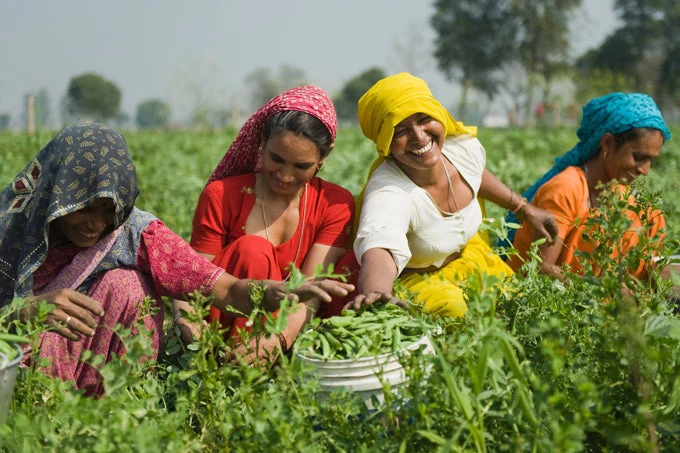This time we were discussing how India can build a stronger agriculture sector without further harm to the environment or depletion of its natural resources. The high-level dialogue was attended by senior representatives from India’s Niti Aayog, Ministry of Agriculture and Farmers’ Welfare, leaders of farmers’ associations from Punjab and Haryana, as well as by researchers, academics, and donors.
We focused on the ‘agriculture-water-energy’ nexus, achieving India’s second green revolution, making agriculture more climate resilient, as well as options to stop the burning of crop residue that is worsening air quality in much of northern India. It was heartening to see the torch bearers of India’s drive towards food security unhesitatingly debate a host of complex and sensitive issues.

Over the past six decades, India has come a long way from being a famine-prone country to comfortably producing food for 1.25 billion people from finite arable land. Food security firmly in hand, the government is now targeting to double farmers’ incomes by 2022. Today, with rapidly growing urban food markets, India is emerging as a global agricultural powerhouse.
At the same time, the comprehensive strategy put in place decades ago to usher in the Green Revolution is inadvertently fostering a “perfect storm” . India is now confronted with the deadly troika of resource degradation, as well as water and air pollution. Given India’s high vulnerability to climate change, these conditions threaten the future sustainability of its food production, the very objective that this bold strategy sought to achieve.
The northern states of Punjab and Haryana, which spearheaded India’s food security, now face multiple environmental problems. Their resource intensive system of rice-wheat production has led to the over-extraction of groundwater, and their imbalanced use of fertilizers has added to soil and water contamination. Recently, the widespread burning of crop residues and its contribution to severe air pollution has attracted both national and global attention. The continuing public procurement of rice and wheat, together with subsidies for fertilizer and energy, and other dis-incentives to use water efficiently - all in the face of a changing climate - have put these states in the eye of a “perfect storm”.
Not surprisingly, all participants echoed the need for a “paradigm shift” to put Indian agriculture on a more resource efficient and resilient path.
So, what does this paradigm shift look like?
First, measures to conserve natural resources, make agriculture climate-resilient, and reduce agricultural pollution must safeguard farmer welfare and contribute to doubling farmers’ incomes. For states such as Punjab and Haryana which are at, or near, the production frontier for cereals, the priority is to shift to high-value agriculture and value addition. Simultaneously, to maintain the country’s food security, public procurement policy will need to be geographically reoriented to areas that are ecologically suited for the cultivation of these staples. The need for such realignment has long been recognized. The country’s current push for “doubling farmer incomes” provides an opportunity to finally make this happen.
Second, technical solutions for conservation and climate-resilient agriculture are readily available. But more effort must be put into making sure that they are widely adopted. Leaders of farmers’ associations reminded us that for farmers to embrace eco-friendly technologies, they need to see results on the ground quickly and, to do so, they need the right knowledge and incentives. Thus, to see real impact, any solutions that we offer to farmers must be sensible as well as scalable. On this, I am happy to note that the World Bank has, or is about to, initiate new agriculture projects in Maharashtra, Andhra Pradesh, Tamil Nadu, Assam, and Jharkhand. These projects focus on providing locally-adapted support packages that promote diversification, make extension and knowledge transfer systems more effective, introduce ICT innovations and climate-smart technologies, as well as support enterprise-based models of value chains.
Third, the consensus around the table was that decision-makers need to revisit policies so that appropriate incentives are provided to farmers to make the right choices on what to produce and how to produce it. To this effect, the distorting effects of water, energy and input subsidies, and price support for rice and wheat were widely acknowledged. It was widely recognized that now is the time to consider how the support provided to farmers can be redirected to transform the vicious circle of resource degradation into a virtuous circle of rapid and sustainable income growth. On this, India can draw upon lessons from countries that have walked this path before. In the European Union, for instance, the switch from coupled subsidies (earmarked for specific crops and distorted input prices) towards decoupled (income) support has resulted in better environmental stewardship and higher farm incomes.
Today, Indian agriculture stands at a crossroads. Inaction is not an option. The challenges are multifaceted, but at the same time, smart solutions are available that have the potential to generate triple-wins, that is, increase productivity, enhance climate resilience, and make agriculture climate-smart by reducing damaging emissions. These solutions can be deployed at scale if current farmer support programs are fully aligned with the government’s target to double farmers’ incomes. As at the time of the Green Revolution, taking India’s food system forward will require bold decisions. Now is the time to take them.


Join the Conversation